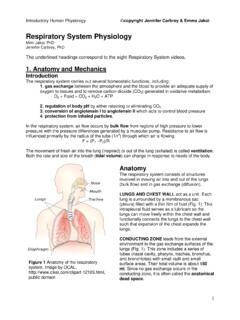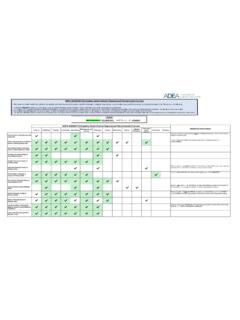Transcription of HYPOTHALAMUS AND PITUITARY GLAND - Duke University
1 introductory Human physiology copyright Emma Jakoi 1 HYPOTHALAMUS AND PITUITARY GLAND Emma R. Jakoi, LEARNING OBJECTIVES 1. Contrast the anterior and posterior PITUITARY with respect to cell types and development. 2. Identify appropriate hypothalamic releasing factors that control the secretion of each of the anterior PITUITARY hormones. 3. Explain the importance of pulsatile and episodic secretion from the HYPOTHALAMUS . 4. Diagram the short loop and long loop negative feedback control of the anterior PITUITARY hormone secretion. Predict changes in the secretory rates of hypothalamic, anterior PITUITARY and target GLAND hormones caused by over secretion or under secretion of any of these hormones or receptor deficit for any of these hormones.
2 5. Describe the regulation and roles of the posterior PITUITARY hormones, oxytocin and vasopressin (ADH). Name the stimuli and mechanisms that control their secretion. 6. Describe the causes and consequences of hypo-secretion of vasopressin (ADH). INTRODUCTION Growth, metabolism, response to stress and reproduction are complex physiological processes that require the integration of multiple systems. In the human body, the HYPOTHALAMUS - PITUITARY GLAND axis serves as the master endocrine GLAND governing these functions. The release of hypothalamic neuropeptides and control of the PITUITARY function is regulated by afferent signals from the brain, viscera, and circulating levels of substrates and hormones.
3 This neuroendocrine axis secretes at least 8 hormones which: - A ct directly on non-endocrine tissues [expl: growth hormone (GH), antidiuretic hormone (ADH)]. - Act to modulate the secretory activity of other endocrine glands [ expl: adenocorticotrophic hormone (ACTH), thyroid stimulating hormone (TSH), follicle stimulating hormone (FSH), lutenizing hormone (LH)]. ANATOMY & TERMS HYPOTHALAMUS - is the area in the brain that is structurally and functionally connected to the PITUITARY GLAND . PITUITARY GLAND - is also called the hypophysis. It aris es from two different tissue sources: posterior PITUITARY is nervous tissue (neurohypophysis) and anterior PITUITARY is glandular (adenohypophysis).
4 Posterior PITUITARY - is the neural portion derived from an extension of the HYPOTHALAMUS (median eminence) which remains connected throughout life by a stalk, called the infundibulum (Fig 1). Anterior PITUITARY is the glandular portion derived from the mouth epithelium ( Rathke s pouch) (Fig 1). It forms a cuff (pars tuberalis) around the infundibulum. Figure 1. Embryological development of the PITUITARY GLAND . Diencephalon (brain) introductory Human physiology copyright Emma Jakoi 2 Hypothalamic-hypophyseal portal tract. Nerve fibers from the HYPOTHALAMUS terminate at capillaries in the infundibulum.
5 The neuro-endocrine peptides secreted by these nerve fibers enter the blood and are carried by veins to a second capillary bed (portal system) in the anterior PITUITARY where they govern the secretory activity of the endocrine cells in the anterior PITUITARY . NEURO-ENDOCRINE CONTROL Hypothalamic hormones are: - peptides called releasing factors. - secreted in an episodic and pulsatile manner. Why is this important? - present at high concentrations at target cell - present at very low concentration in systemic blood. Actions of hypothalamic peptides include: - binding to plasma membrane receptors. - release of stored target hormones (in PITUITARY ) via exocytosis.
6 - increase of transcription of target hormones. - modulation of their receptor activity (up regulation; down regulation). Summary of regulatory factors and targets for PITUITARY hormones PITUITARY Hormone Hypothalamic Releasing Factor Hypothalamic Inhibitory Factor Target organ Biological role GH Prl GHRH PrlRH SRIF Dopamine Bone & liver breast Growth milk LH & FSH TSH GnRH TRH Gonads Thyroid GLAND Reproduction Basal metabolic rate ACTH CRH Adrenal Response to stress TRH GnRH CRH GHRH Somatostatin PrlRH Dopamine Releasing Factors: G-coupled receptors PITUITARY Cells: TSH LH & ACTH GH Prl FSH Target Organ.
7 G protein coupled receptors___enzyme associated receptors introductory Human physiology copyright Emma Jakoi 3 REGULATION BY FEEDBACK LOOPS The HYPOTHALAMUS regulates PITUITARY function with change in temperature, energy needs, or fluid balance. It is one of the few areas in the brain not sealed off from the blood (blood-brain barrier) and therefore can monitor and respond to substances within the blood, permitting hormonal feedback. The negative feed back loops that govern the hypothalamic- PITUITARY axis include (Fig 2): Long loop feedback: hormones from peripheral endocrine glands can exert feedback control on the HYPOTHALAMUS and anterior PITUITARY .
8 This feedback is usually negative. Short-loop feedback: Negative feedback by PITUITARY hormones can inhibit the synthesis and/or secretion of the related hypothalamic hormones. Figure 2. Negative feedback loops in a typical HYPOTHALAMUS - PITUITARY -peripheral GLAND axis. X, a peripheral hormone: XTH, a PITUITARY tropic hormone; XRH, the releasing hormone; XIH, the inhibiting hormone. GH SECRETION FROM ANTERIOR PITUITARY Growth hormone (GH) secretion is governed by the HYPOTHALAMUS in a pulsatile and episodic manner. Maximum secretion of GH occurs during sleep (Fig 3). Figure 3. Growth hormone exhibits a circadian rhythm with maximal secretion during early sleep.
9 introductory Human physiology copyright Emma Jakoi 4 GH secretion is regulated in a positive manner by GHRH from the HYPOTHALAMUS and in a negative manner by two hormones, insulin-like growth factor (IGF-1) from the liver and by somatostatin (SRIF) secreted by the HYPOTHALAMUS (Fig 4). Somatostatin (SRIF) and growth hormone releasing hormone (GHRH) bind to two different receptors coupled to the same second messenger but in opposing manner. Their net effect governs secretion of GH from the PITUITARY target cells. What are the target organs and the effects of GH and IGF-1? After birth, GH governs longitudinal growth of the skeleton (body height).
10 IGF-1 governs growth of the internal organs. During embryonic development, IGF-1 is essential for growth of the fetus. Figure 4. Regulation of GH secretion. Note that GH alters metabolism (Fig 5) preventing glucose storage in muscle and fat. This effect raises circulating levels of glucose in the blood for ready access by growing tissues. Recently, GH has been shown to enhance growth of muscles used in anaerobic exercise such as weight lifting and to enhance the metabolism of lactic acid to glucose in the liver. Figure 5. Effects of growth hormone (GH) on target tissues and organs. introductory Human physiology copyright Emma Jakoi 5 PATHOLOGY Hyper-secretion.









